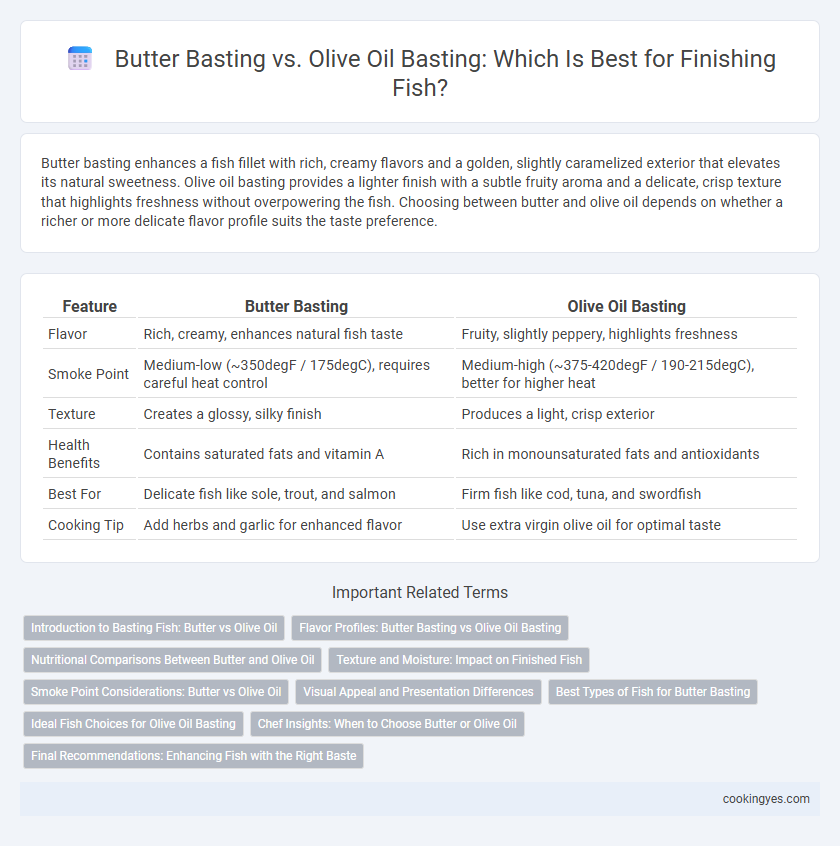Butter basting enhances a fish fillet with rich, creamy flavors and a golden, slightly caramelized exterior that elevates its natural sweetness. Olive oil basting provides a lighter finish with a subtle fruity aroma and a delicate, crisp texture that highlights freshness without overpowering the fish. Choosing between butter and olive oil depends on whether a richer or more delicate flavor profile suits the taste preference.
Table of Comparison
| Feature | Butter Basting | Olive Oil Basting |
|---|---|---|
| Flavor | Rich, creamy, enhances natural fish taste | Fruity, slightly peppery, highlights freshness |
| Smoke Point | Medium-low (~350degF / 175degC), requires careful heat control | Medium-high (~375-420degF / 190-215degC), better for higher heat |
| Texture | Creates a glossy, silky finish | Produces a light, crisp exterior |
| Health Benefits | Contains saturated fats and vitamin A | Rich in monounsaturated fats and antioxidants |
| Best For | Delicate fish like sole, trout, and salmon | Firm fish like cod, tuna, and swordfish |
| Cooking Tip | Add herbs and garlic for enhanced flavor | Use extra virgin olive oil for optimal taste |
Introduction to Basting Fish: Butter vs Olive Oil
Basting fish with butter enhances flavor by adding richness and promoting a golden, crispy crust due to its milk solids, making it ideal for delicate or fatty fish like salmon. Olive oil basting offers a lighter, heart-healthy option that preserves the fish's natural taste while providing a higher smoke point suited for firmer varieties such as cod or halibut. Choosing between butter and olive oil depends on desired flavor intensity and cooking temperature, optimizing texture and taste during the finishing process.
Flavor Profiles: Butter Basting vs Olive Oil Basting
Butter basting imparts a rich, creamy flavor with subtle nutty undertones that enhance the fish's natural sweetness, creating a luxurious and indulgent taste. Olive oil basting delivers a fruity, slightly peppery profile that adds a fresh, Mediterranean character while maintaining a lighter mouthfeel. Both methods elevate flavor complexity, but butter emphasizes richness whereas olive oil highlights brightness and earthiness.
Nutritional Comparisons Between Butter and Olive Oil
Butter basting provides rich amounts of saturated fats and fat-soluble vitamins such as A and E, contributing to flavor and nutritional complexity in fish dishes. Olive oil basting offers higher levels of monounsaturated fats, particularly oleic acid, alongside antioxidants like polyphenols, which support heart health and reduce inflammation. Choosing olive oil over butter can enhance the nutritional profile of finished fish by promoting healthier lipid intake and providing beneficial phytochemicals.
Texture and Moisture: Impact on Finished Fish
Butter basting imparts a rich, creamy texture and enhances moisture retention in fish due to its milk solids and fat content, resulting in a tender, succulent finish. Olive oil basting provides a lighter, slightly fruity coating that preserves the fish's natural moisture while promoting a delicate, silky texture without the risk of burning associated with butter. The choice between butter and olive oil ultimately influences the mouthfeel and juiciness of the cooked fish, with butter offering a more luxurious texture and olive oil maintaining a clean, fresh finish.
Smoke Point Considerations: Butter vs Olive Oil
Butter has a lower smoke point, around 302degF (150degC), making it prone to burning quickly during high-heat finishing, which can impart a bitter flavor to fish. Extra virgin olive oil offers a higher smoke point, typically between 375-410degF (190-210degC), allowing for safer basting at elevated temperatures without compromising flavor. Choosing olive oil for basting enhances the fish's finish by preventing burnt residues and maintaining a cleaner, richer taste.
Visual Appeal and Presentation Differences
Butter basting imparts a rich, golden-brown glaze to fish, enhancing its visual appeal with a lustrous, slightly caramelized finish that highlights natural textures. Olive oil basting creates a subtle sheen and preserves the fish's natural color, offering a more matte and vibrant presentation. The choice between butter and olive oil affects the visual contrast on plating, with butter providing a warm, indulgent look and olive oil maintaining a fresh, Mediterranean aesthetic.
Best Types of Fish for Butter Basting
Butter basting enhances the flavor and texture of fatty fish such as salmon, trout, and mackerel by providing a rich, creamy finish that complements their natural oils. Olive oil basting is better suited for leaner fish like cod, halibut, and tilapia, offering a lighter, fruitier taste while preventing drying. For optimal results, choose fish with higher fat content for butter basting and reserve olive oil basting for delicate, white-fleshed varieties.
Ideal Fish Choices for Olive Oil Basting
Ideal fish choices for olive oil basting include fatty fish like salmon, trout, and mackerel, which benefit from the oil's ability to enhance natural richness without overpowering. Olive oil's moderate smoke point and fruity flavor complement these oily fish by maintaining moisture and adding subtle complexity during finishing. Leaner fish such as cod or sole may not pair as well, as they require a different fat profile to avoid drying out under olive oil's relatively lower heat tolerance.
Chef Insights: When to Choose Butter or Olive Oil
Butter basting enhances fish with rich, creamy flavors and provides a golden, caramelized finish ideal for delicate white fish like cod or sole. Olive oil basting delivers a lighter, fruitier taste and higher smoke point, making it perfect for robust, oily fish such as salmon or mackerel. Chefs often prefer butter for a luxurious finish in pan-seared dishes, while olive oil suits high-heat cooking and Mediterranean-style preparations.
Final Recommendations: Enhancing Fish with the Right Baste
Butter basting imparts a rich, creamy flavor and promotes a golden, caramelized crust on fish, enhancing its natural succulence. Olive oil basting offers a lighter, fruitier finish with healthful monounsaturated fats, preserving the fish's delicate texture and adding subtle herbal notes. For optimal results, use butter basting for robust, firm-fleshed fish like salmon or cod, and olive oil basting for tender, flaky varieties such as sole or sea bass.
Butter basting vs Olive oil basting for finishing Infographic

 cookingyes.com
cookingyes.com